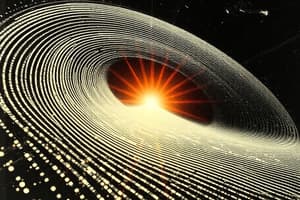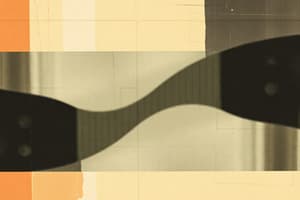Podcast
Questions and Answers
What is the result when two waves interfere constructively?
What is the result when two waves interfere constructively?
- They produce interference patterns without affecting amplitude.
- They create a wave with zero displacement.
- They cancel each other out.
- They create a wave with a larger amplitude. (correct)
In the two-slit experiment, what causes the appearance of the interference pattern?
In the two-slit experiment, what causes the appearance of the interference pattern?
- The slits scatter light waves in random directions.
- The intensity of the light beam impacts the pattern directly.
- Light waves diffract and overlap, reinforcing or canceling each other. (correct)
- The light waves reflect off the edges of the slits.
What role does Planck's constant play in the energy of a particle?
What role does Planck's constant play in the energy of a particle?
- It adjusts the amplitude of wave motion.
- It relates energy to frequency of the particle. (correct)
- It measures the wavelength of emitted light.
- It determines the speed of the particle.
What phenomenon occurs when two waves overlap and produce regions of no displacement?
What phenomenon occurs when two waves overlap and produce regions of no displacement?
What does wave-particle duality imply about light and other particles?
What does wave-particle duality imply about light and other particles?
What defines the behavior of particles on the atomic level according to quantum mechanics?
What defines the behavior of particles on the atomic level according to quantum mechanics?
What is produced when a wave reflects off the end of a string in a musical instrument?
What is produced when a wave reflects off the end of a string in a musical instrument?
What is the momentum of a particle expressed by?
What is the momentum of a particle expressed by?
What is the relationship between intensity and the amplitude of a light wave?
What is the relationship between intensity and the amplitude of a light wave?
How is intensity expressed when light is considered as a stream of particles?
How is intensity expressed when light is considered as a stream of particles?
What does the square of the wave's amplitude indicate in relation to finding a quantum particle?
What does the square of the wave's amplitude indicate in relation to finding a quantum particle?
What was a key concern for some physicists regarding the probabilistic nature of quantum physics?
What was a key concern for some physicists regarding the probabilistic nature of quantum physics?
What conclusion is drawn when measuring many particles in terms of their location?
What conclusion is drawn when measuring many particles in terms of their location?
What dilemma arises when considering the intensity of light in a double-slit experiment with low intensity?
What dilemma arises when considering the intensity of light in a double-slit experiment with low intensity?
Which physicist famously argued against the idea of inherent uncertainties in nature?
Which physicist famously argued against the idea of inherent uncertainties in nature?
What aspect of quantum physics did Bohr and Einstein notably debate?
What aspect of quantum physics did Bohr and Einstein notably debate?
Flashcards are hidden until you start studying
Study Notes
Wave interference
- Constructive interference occurs when two waves combine to produce a wave with a larger amplitude than either of the original waves.
Two-slit experiment
- The two-slit experiment demonstrates the wave-like nature of light.
- When light passes through two slits, an interference pattern is observed on a screen behind the slits.
- The pattern consists of alternating bright and dark bands - bright bands occur where the waves from each slit interfere constructively, while dark bands occur where the waves interfere destructively.
Planck's constant
- Planck's constant (h) is a fundamental constant in quantum mechanics.
- It relates the energy of a photon to its frequency.
- The energy of a particle is quantized, meaning it can only exist in discrete values that are multiples of Planck's constant.
Wave interactions
- Destructive interference occurs when two waves combine to produce a wave with a smaller amplitude than either of the original waves.
- This can result in regions of no displacement, where the waves completely cancel each other out.
Wave-particle duality
- Wave-particle duality suggests that light and matter can exhibit both wave-like and particle-like properties.
- Light can act as both a wave and a stream of particles called photons.
- Other particles, such as electrons, can also exhibit wave-like behavior.
Quantum mechanics
- Quantum mechanics is a theory that describes the behavior of matter and energy at the atomic and subatomic level.
- It is based on the idea that particles exist in a state of superposition, meaning they can be in multiple states at the same time.
- The behavior of particles is determined by probability waves, which describe the likelihood of finding the particle in a particular location.
Sound waves
- Standing waves are produced when a wave reflects off the end of a string in a musical instrument.
- They are formed by the interference of the original wave and its reflected wave.
- This results in a wave pattern that appears to be stationary, with points of maximum amplitude (antinodes) and points of zero amplitude (nodes).
Momentum
- The momentum of a particle is a measure of its mass and velocity.
- The momentum of a particle can be expressed as the product of its mass (m) and velocity (v):
- Momentum (p) = mass (m) x velocity (v).
Wave Properties and Particle Properties
- Waves have three independent properties: frequency, wavelength, and amplitude.
- Wave speed can be calculated from frequency and wavelength
- Particle properties relate frequency to energy and wavelength to momentum.
- Intensity of light is proportional to the square of the light wave's amplitude.
Intensity and Probability
- Intensity, when viewed as a stream of particles, is proportional to the number of particles passing per second.
- The number of particles is proportional to the square of the wave's amplitude.
- The square of the wave's amplitude at a given location is proportional to the probability of finding the particle at that location.
- The percentage of particles at a given location is equal to the probability, which is proportional to the square of the wave's amplitude.
Wave-Particle Duality and Probabilistic Rule
- This concept has been debated as it suggests that nature is fundamentally unpredictable.
- This concept was questioned by physicists like Einstein who believed that "God does not play dice" and dedicated his life to finding a more deterministic theory.
- The position of a quantum particle is measured, the probability of finding it at a specific location is given by the square of the quantum wave's amplitude at that location.
Studying That Suits You
Use AI to generate personalized quizzes and flashcards to suit your learning preferences.




